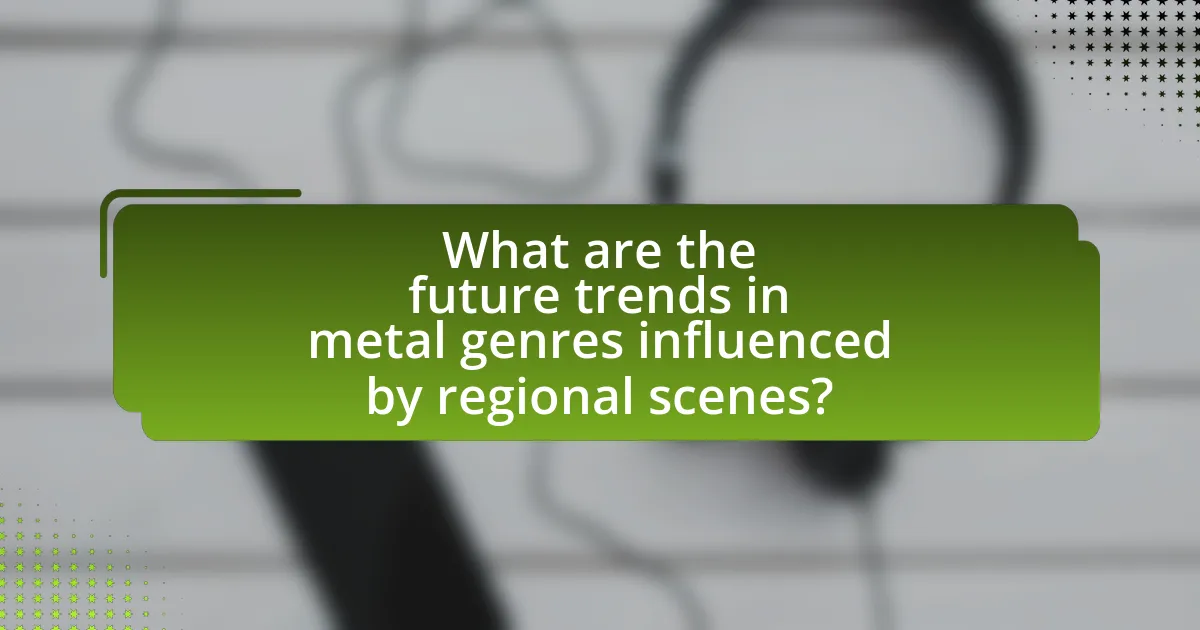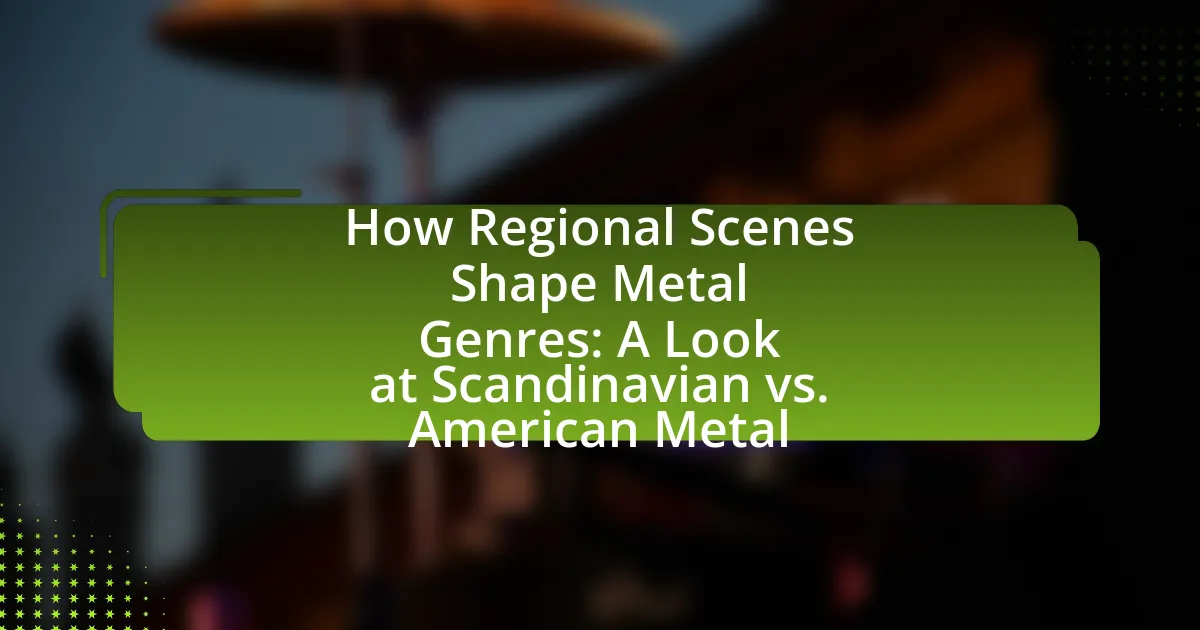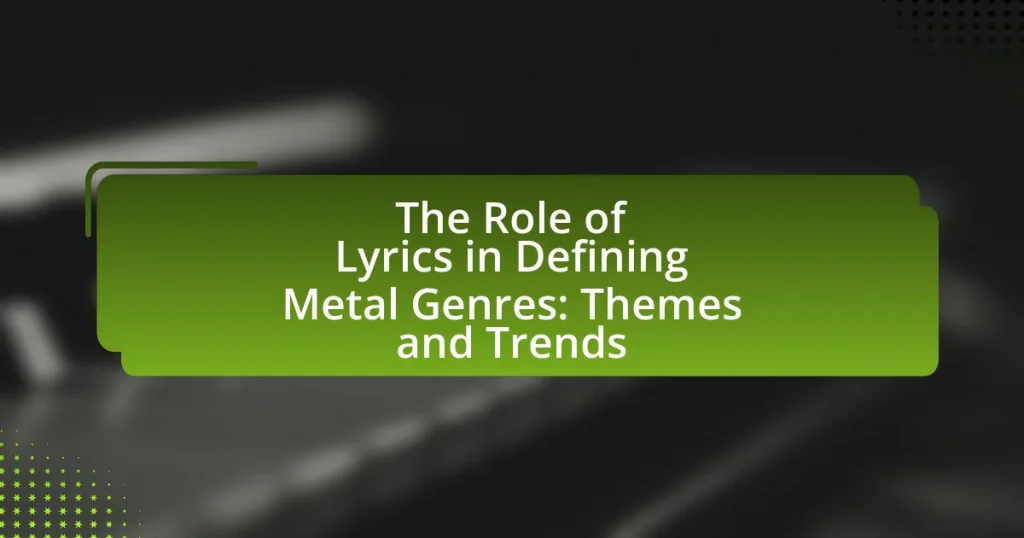The article examines how regional scenes, specifically Scandinavian and American metal, influence the development of metal genres. It highlights the distinct characteristics of Scandinavian metal, which often incorporates folklore and atmospheric elements, and contrasts them with the diverse subgenres of American metal, shaped by themes of rebellion and individualism. The discussion includes the impact of cultural backgrounds, historical events, and local music industries on genre evolution, as well as the role of collaborations and festivals in fostering innovation. Additionally, it explores future trends in metal influenced by globalization and technology, emphasizing the importance of supporting regional scenes for the continued growth of the genre.

How do regional scenes influence the development of metal genres?
Regional scenes significantly influence the development of metal genres by shaping musical styles, lyrical themes, and cultural identities. For instance, Scandinavian metal often incorporates elements of folklore and mythology, reflecting the region’s cultural heritage, while American metal tends to emphasize themes of rebellion and individualism, influenced by the country’s diverse social landscape. The emergence of subgenres like black metal in Norway and thrash metal in the United States illustrates how local scenes foster unique sounds and ideologies. Additionally, the presence of local venues, festivals, and communities supports the growth of these genres, allowing artists to collaborate and innovate within their specific cultural contexts.
What are the key characteristics of Scandinavian metal?
Scandinavian metal is characterized by its melodic elements, atmospheric soundscapes, and incorporation of folk influences. Bands from this region often blend heavy guitar riffs with symphonic orchestration, creating a rich and layered musical experience. Notably, genres such as melodic death metal and black metal emerged prominently from Scandinavia, with bands like In Flames and Darkthrone exemplifying these styles. The lyrical themes frequently explore nature, mythology, and existentialism, reflecting the cultural and historical context of the region. This unique combination of musical complexity and thematic depth has established Scandinavian metal as a significant force in the global metal scene.
How does the cultural background shape Scandinavian metal music?
Cultural background significantly shapes Scandinavian metal music by infusing it with themes of mythology, nature, and existentialism, reflecting the region’s historical and social context. The influence of Norse mythology is prevalent in the lyrics and imagery of many Scandinavian metal bands, such as Amon Amarth, which draws on Viking history and legends. Additionally, the harsh Nordic landscapes inspire a sense of isolation and introspection, often explored in the music’s atmospheric elements, as seen in bands like Opeth and Dark Tranquillity. Furthermore, the cultural emphasis on community and collective identity in Scandinavian societies fosters a strong underground metal scene, promoting collaboration and innovation among artists. This cultural interplay results in a distinctive sound that resonates with both local and global audiences, establishing Scandinavian metal as a unique genre within the broader metal landscape.
What role do local traditions play in the sound of Scandinavian metal?
Local traditions significantly influence the sound of Scandinavian metal by integrating elements from folklore, mythology, and regional musical styles. Bands often draw inspiration from Norse mythology, incorporating themes and narratives that resonate with local cultural heritage, which can be heard in the lyrical content and visual aesthetics of the music. For example, the use of traditional instruments, such as the Hardanger fiddle, alongside heavy guitar riffs creates a unique sound that reflects the region’s history and identity. Additionally, the incorporation of local dialects and storytelling traditions enhances the authenticity and emotional depth of the music, making it distinct from other metal genres. This blending of local traditions with metal has led to the emergence of subgenres like Viking metal, which explicitly celebrates Scandinavian heritage through its musical and thematic elements.
What defines American metal and its regional variations?
American metal is defined by its diverse subgenres, regional influences, and cultural contexts, which vary significantly across the country. For instance, the thrash metal scene in the Bay Area, characterized by bands like Metallica and Slayer, emphasizes speed and aggression, while the Southern metal scene, exemplified by Pantera, incorporates elements of groove and blues. Additionally, the Northeast showcases a strong hardcore influence, with bands like Hatebreed blending metal with punk elements. These regional variations reflect local musical traditions, social issues, and cultural identities, making American metal a rich tapestry of sounds and styles. The distinct characteristics of each region contribute to the overall evolution of the genre, showcasing how geography and culture shape musical expression.
How do historical events influence American metal genres?
Historical events significantly influence American metal genres by shaping their themes, lyrical content, and musical styles. For instance, the Vietnam War and the social upheaval of the 1960s and 1970s inspired bands like Metallica and Slayer to address issues of war, violence, and societal disillusionment in their music. Additionally, the rise of the punk movement in the late 1970s introduced a raw, aggressive sound that influenced the development of thrash metal, characterized by fast tempos and complex guitar riffs. The economic downturns and political tensions in the 1980s also led to the emergence of subgenres like nu-metal, which incorporated elements of hip-hop and alternative rock, reflecting the frustrations of a disenchanted youth. These historical contexts provide a framework for understanding the evolution of American metal, as artists respond to and reflect the societal issues of their times.
What are the major subgenres of American metal and their origins?
The major subgenres of American metal include thrash metal, death metal, black metal, and metalcore, each with distinct origins. Thrash metal emerged in the early 1980s, primarily in California, characterized by fast tempos and aggressive guitar riffs, with bands like Metallica and Slayer leading the movement. Death metal originated in the mid-1980s in Florida, known for its heavy use of distortion and growled vocals, with pioneers such as Death and Morbid Angel. Black metal, while having roots in earlier heavy metal, gained prominence in the early 1990s in the United States, influenced by the Norwegian scene, with bands like Emperor and Immortal shaping its sound. Metalcore, which blends elements of hardcore punk and metal, developed in the late 1990s and early 2000s, with bands like Killswitch Engage and Unearth representing this subgenre. Each of these subgenres reflects the regional influences and cultural contexts of their origins within the American metal scene.
How do Scandinavian and American metal scenes compare?
Scandinavian and American metal scenes differ significantly in their musical styles, cultural influences, and historical development. Scandinavian metal, particularly from countries like Sweden and Norway, is known for its melodic death metal and black metal subgenres, characterized by atmospheric elements and themes of nature and mythology. In contrast, the American metal scene has a broader range of styles, including thrash, nu-metal, and metalcore, often emphasizing aggression and technical proficiency.
The emergence of Scandinavian metal can be traced back to the early 1990s, with bands like Mayhem and Darkthrone pioneering black metal, which has since influenced countless artists globally. American metal, on the other hand, gained prominence in the 1980s with bands like Metallica and Slayer, who shaped the thrash metal genre and contributed to the global metal landscape.
Culturally, Scandinavian metal often reflects the region’s folklore and history, while American metal tends to address themes of rebellion, personal struggle, and social issues. This divergence in thematic content is evident in the lyrical focus of prominent bands from each region. For example, Amon Amarth from Sweden often draws on Norse mythology, whereas Slipknot from the U.S. explores themes of inner turmoil and societal critique.
Overall, while both scenes share a passion for heavy music, their distinct characteristics and influences create unique identities within the global metal community.
What are the similarities and differences in themes between the two regions?
Scandinavian and American metal share themes of rebellion and existential struggle, yet they differ in cultural influences and lyrical focus. Both regions explore themes of darkness, personal conflict, and societal critique, reflecting a common foundation in heavy metal’s roots. However, Scandinavian metal often incorporates elements of mythology, nature, and folklore, as seen in bands like Amon Amarth, which draws on Norse mythology. In contrast, American metal frequently emphasizes individualism and personal experiences, with bands like Metallica addressing themes of alienation and societal issues. This divergence illustrates how regional cultural contexts shape the thematic expressions within the metal genre.
How do the fan cultures in Scandinavia and America differ?
Fan cultures in Scandinavia and America differ primarily in their levels of community engagement and the intensity of their loyalty to specific metal subgenres. In Scandinavia, fans often exhibit a strong sense of local identity and community, frequently participating in festivals and gatherings that celebrate regional metal scenes, such as Sweden Rock Festival and Wacken Open Air in Germany, which attracts many Scandinavian fans. This communal aspect fosters a deep connection among fans and artists, often leading to a more intimate concert experience.
In contrast, American fan culture tends to be more individualistic, with a broader focus on mainstream metal and a diverse range of subgenres. While large festivals like Ozzfest and Download Festival exist, American fans often engage with metal through a wider array of media, including online platforms and social networks, which can dilute the sense of community found in Scandinavian cultures. This difference is reflected in the way fans interact with bands, with Scandinavian fans often showing more loyalty to local acts, while American fans may gravitate towards a mix of both local and international artists.

What impact do regional scenes have on the evolution of metal music?
Regional scenes significantly influence the evolution of metal music by shaping its sound, themes, and cultural identity. For instance, Scandinavian metal often incorporates elements of folklore and nature, reflecting the region’s cultural heritage, while American metal tends to emphasize themes of rebellion and individualism, influenced by its diverse cultural landscape. The emergence of subgenres, such as black metal in Norway and thrash metal in the United States, illustrates how local scenes foster unique musical characteristics and lyrical content. Additionally, the interaction between local bands and audiences creates a feedback loop that drives innovation and experimentation within the genre, further solidifying the impact of regional scenes on metal music’s evolution.
How does the local music industry affect metal genre development?
The local music industry significantly influences metal genre development by shaping the cultural context, providing platforms for emerging artists, and fostering community engagement. In regions with a robust local music scene, such as Scandinavia, the industry supports diverse subgenres like black metal and folk metal, which thrive due to local traditions and collaborations among musicians. For instance, Norway’s black metal scene gained prominence in the early 1990s, driven by local labels and venues that promoted underground bands, leading to a distinct sound characterized by atmospheric elements and lyrical themes rooted in Norse mythology. Conversely, in the American metal scene, the industry has facilitated the rise of genres like metalcore and nu-metal, influenced by the fusion of various musical styles and the accessibility of digital platforms for distribution. This dynamic interaction between local industry support and genre evolution illustrates how regional characteristics and industry infrastructure can shape the development of metal music.
What role do record labels play in shaping regional metal scenes?
Record labels play a crucial role in shaping regional metal scenes by providing financial support, marketing resources, and distribution channels for local bands. They often identify and promote emerging talent, which helps to establish a unique sound and identity within a specific region. For instance, labels like Nuclear Blast in Europe have been instrumental in promoting European metal bands, influencing the development of subgenres such as melodic death metal in Scandinavia. Additionally, record labels facilitate collaborations and tours, further solidifying the local scene’s cohesion and visibility. This dynamic not only enhances the popularity of regional acts but also contributes to the overall evolution of metal music within that area.
How do local venues and festivals contribute to genre evolution?
Local venues and festivals significantly contribute to genre evolution by providing platforms for emerging artists to showcase their work and experiment with new sounds. These spaces foster community engagement and collaboration among musicians, which leads to the blending of styles and the birth of new subgenres. For instance, the annual Roskilde Festival in Denmark has been instrumental in promoting diverse acts, allowing for cross-pollination between genres like metal and punk, thus influencing the evolution of Scandinavian metal. Similarly, local venues in the U.S. have historically served as incubators for genres like thrash metal, with clubs in the Bay Area hosting bands that would define the genre, such as Metallica and Slayer. This localized support not only nurtures talent but also shapes the cultural identity of the genre, making it responsive to regional influences and trends.
What influences do regional collaborations have on metal music?
Regional collaborations significantly influence metal music by blending diverse cultural elements and musical styles, which enriches the genre. For instance, Scandinavian metal often incorporates folk melodies and themes from local mythology, while American metal may integrate blues and punk influences. This cross-pollination leads to the emergence of unique subgenres, such as melodic death metal in Sweden, which combines traditional heavy metal with local musical traditions. Additionally, collaborations between bands from different regions can result in innovative sounds and lyrical themes that reflect a fusion of cultural identities, enhancing the global appeal of metal music.
How do cross-regional collaborations shape the sound of metal?
Cross-regional collaborations significantly shape the sound of metal by blending diverse musical influences and techniques from different cultures. For instance, Scandinavian metal often incorporates elements of folk music and melodic structures, while American metal may emphasize heavier riffs and aggressive vocals. This fusion creates unique subgenres, such as melodic death metal, which combines the intricate melodies of Scandinavian styles with the intensity of American metal. Additionally, collaborations between artists from these regions can lead to innovative songwriting and production techniques, as seen in projects like the collaboration between Swedish band Opeth and American producer Steven Wilson, which resulted in a distinctive sound that merges progressive rock with metal. Such partnerships not only expand the sonic palette of metal but also foster a global community that influences the evolution of the genre.
What are some notable collaborations between Scandinavian and American metal artists?
Notable collaborations between Scandinavian and American metal artists include the partnership between Swedish guitarist Yngwie Malmsteen and American vocalist Jeff Scott Soto on the album “Rising Force,” which showcased a blend of neoclassical metal influences. Another significant collaboration is the work of Finnish band Nightwish with American vocalist Tarja Turunen, particularly on the album “Wishmaster,” which combined symphonic elements with metal. Additionally, the collaboration between Swedish band Opeth and American producer Steven Wilson has resulted in critically acclaimed albums like “Blackwater Park,” merging progressive rock and metal. These collaborations highlight the cross-pollination of styles and techniques between the two regions, enriching the global metal scene.

What are the future trends in metal genres influenced by regional scenes?
Future trends in metal genres influenced by regional scenes include the rise of hybrid styles that blend traditional elements with modern influences, particularly seen in Scandinavian and American metal. Scandinavian metal is increasingly incorporating folk and atmospheric elements, reflecting regional cultural heritage, while American metal is diversifying with influences from hip-hop and electronic music, showcasing a fusion of genres. This trend is supported by the growing popularity of bands like Heilung in Scandinavia, which emphasizes ancestral sounds, and the emergence of artists like Code Orange in the U.S., who integrate various musical styles into their metal framework. These developments indicate a shift towards more eclectic and culturally rich expressions within the metal genre, driven by the unique characteristics of regional scenes.
How are globalization and technology affecting regional metal scenes?
Globalization and technology are significantly transforming regional metal scenes by facilitating cross-cultural exchanges and enhancing accessibility to music production and distribution. The internet allows metal bands from diverse regions to share their music globally, leading to the blending of styles and influences, as seen in the rise of genres like metalcore and djent, which incorporate elements from various cultures. Additionally, platforms like Bandcamp and Spotify enable independent artists to reach international audiences without traditional record label support, exemplified by the success of bands from countries like Finland and Sweden, which have gained worldwide recognition. This interconnectedness fosters a more diverse metal landscape, where regional characteristics can be both preserved and innovated upon, ultimately enriching the global metal community.
What role does social media play in the dissemination of metal music?
Social media plays a crucial role in the dissemination of metal music by providing platforms for artists to share their work, engage with fans, and build communities. Through platforms like Facebook, Instagram, and Twitter, metal bands can promote new releases, announce tours, and connect directly with their audience, which enhances visibility and reach. For instance, a study by the International Journal of Music Business Research found that 70% of independent metal bands utilize social media for marketing, demonstrating its significance in the industry. Additionally, social media facilitates the discovery of new subgenres and regional scenes, allowing fans to explore diverse metal styles from different cultures, such as Scandinavian and American metal, thus influencing the global metal landscape.
How are emerging artists from different regions influencing traditional metal genres?
Emerging artists from different regions are influencing traditional metal genres by integrating local cultural elements and diverse musical styles into their sound. For instance, Scandinavian metal often incorporates folk melodies and themes from Norse mythology, as seen in bands like Finntroll and Korpiklaani, which blend metal with traditional Finnish music. In contrast, American metal artists frequently draw from a variety of influences, including blues and punk, as exemplified by bands like Mastodon and Lamb of God, who incorporate complex rhythms and lyrical storytelling. This regional blending not only diversifies the metal genre but also creates unique subgenres, such as folk metal in Scandinavia and sludge metal in the American South, showcasing how local scenes shape and redefine traditional metal.
What can fans expect from the evolution of metal genres in the coming years?
Fans can expect increased fusion of metal genres, driven by the blending of regional influences from Scandinavian and American scenes. This evolution will likely see Scandinavian metal’s melodic and atmospheric elements merging with the aggressive and diverse styles of American metal, resulting in innovative subgenres. For instance, the rise of bands that incorporate folk and electronic elements into traditional metal showcases this trend, reflecting a broader acceptance of genre experimentation. Additionally, the global accessibility of music through streaming platforms will facilitate cross-cultural collaborations, further enriching the metal landscape.
How might cultural exchanges between regions shape future metal sounds?
Cultural exchanges between regions can significantly shape future metal sounds by introducing diverse musical elements, techniques, and themes. For instance, Scandinavian metal often incorporates folk melodies and atmospheric elements, while American metal may emphasize aggression and technical proficiency. The blending of these styles can lead to innovative subgenres, as seen in the rise of melodic death metal, which combines the melodic aspects of Scandinavian music with the intensity of American metal. Historical examples include the influence of European metal bands on American acts in the 1980s, which led to the development of thrash metal. This cross-pollination fosters creativity and expands the sonic palette of metal, allowing for the emergence of new sounds that reflect a fusion of cultural identities.
What are some predictions for the next wave of metal genres?
Predictions for the next wave of metal genres include the rise of regional subgenres that blend traditional elements with modern influences, particularly from Scandinavian and American scenes. Scandinavian metal is expected to continue evolving with a focus on atmospheric and melodic elements, potentially leading to the emergence of new styles that incorporate folk and electronic influences. In contrast, American metal may see a resurgence of groove and nu-metal, driven by nostalgia and the integration of hip-hop elements. This evolution is supported by the increasing popularity of bands that fuse these styles, as evidenced by the success of artists like Ghost and Code Orange, who draw from both regional traditions and contemporary trends.
What are the best practices for supporting regional metal scenes?
The best practices for supporting regional metal scenes include fostering local talent through dedicated venues, promoting community engagement, and facilitating collaboration among artists. Dedicated venues provide a platform for local bands to perform, which is essential for building a fan base and gaining exposure. Community engagement can be enhanced by organizing events such as festivals, workshops, and meet-and-greets that connect fans and musicians, thereby strengthening the local scene. Collaboration among artists, including cross-genre projects and joint performances, can lead to innovative sounds and greater visibility for the regional metal genre. These practices are validated by the success of local scenes in places like Scandinavia, where strong community support has led to the emergence of globally recognized metal bands.



